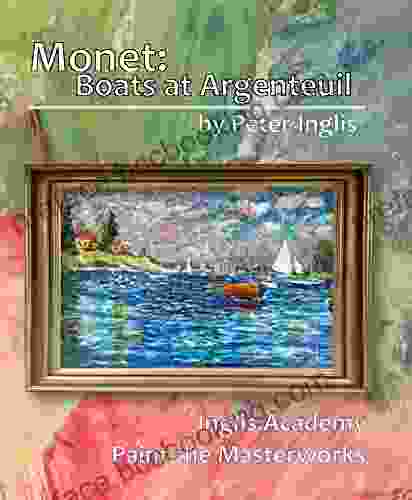Boats at Argenteuil: A Masterpiece of Impressionism by Claude Monet

Claude Monet's "Boats at Argenteuil" is a seminal work of Impressionism, capturing the essence of light and movement on the banks of the Seine River. Painted in 1874, the painting depicts several sailboats gliding gracefully across the sparkling water, surrounded by lush greenery and bathed in a warm summer light. This article delves into the history, significance, and artistic techniques employed by Monet in this masterpiece, providing a comprehensive exploration of one of the most iconic works of art in the Impressionist movement.
In the mid-19th century, a group of young artists in France began to challenge the conventions of traditional painting. Led by Monet, they sought to capture the fleeting effects of light and atmosphere, breaking away from the rigid academic style of painting that had dominated art for centuries. This new approach became known as Impressionism, and "Boats at Argenteuil" stands as one of its most celebrated examples.
Argenteuil, located northwest of Paris on the banks of the Seine, was a popular destination for Impressionist painters. Monet himself lived in Argenteuil from 1871 to 1878, and the town's picturesque landscapes and vibrant riverfront provided ample inspiration for his work. "Boats at Argenteuil" was painted during a particularly productive period in Monet's career, when he was experimenting with the effects of light and color to create the illusion of depth and movement.
4.2 out of 5
| Language | : | English |
| File size | : | 11578 KB |
| Text-to-Speech | : | Enabled |
| Screen Reader | : | Supported |
| Enhanced typesetting | : | Enabled |
| Print length | : | 136 pages |
| Lending | : | Enabled |
Monet's "Boats at Argenteuil" is characterized by several innovative artistic techniques that define the Impressionist style.
Brushstrokes and Color
Monet applied short, visible brushstrokes in a variety of colors to create the impression of light reflecting off the water and boats. The vibrant blues, greens, and yellows of the painting capture the shimmering effects of sunlight on the Seine, while the darker shadows and reflections create depth and movement.
Light and Atmosphere
One of the most striking aspects of "Boats at Argenteuil" is Monet's masterful use of light and atmosphere. The painting portrays a warm, hazy summer day, with the sun casting a golden glow across the scene. The hazy atmosphere creates a sense of depth and distance, drawing the viewer into the painting's tranquil setting.
Composition
Monet carefully arranged the elements of "Boats at Argenteuil" to create a harmonious and dynamic composition. The sailboats are placed off-center, creating a sense of movement and asymmetry. The horizon line is high, allowing for a greater emphasis on the sky and water, which dominate the painting's composition.
"Boats at Argenteuil" was a pivotal work in Monet's career and the development of Impressionism as a whole. It was exhibited at the first Impressionist exhibition in Paris in 1874, where it garnered both praise and criticism from critics. However, the painting's innovative style and groundbreaking techniques would later be recognized as hallmarks of the Impressionist movement.
Today, "Boats at Argenteuil" is considered one of Monet's most important works and a masterpiece of Impressionism. It is housed in the Musée d'Orsay in Paris, where it continues to inspire and captivate viewers with its vibrant colors, masterful brushwork, and the timeless beauty of the Seine River.
Claude Monet's "Boats at Argenteuil" is a testament to the artist's genius and the transformative power of Impressionism. Through his innovative techniques and keen observation of nature, Monet captured the essence of light, movement, and atmosphere in a single painting. "Boats at Argenteuil" remains an iconic work of art, embodying the spirit of Impressionism and continuing to inspire generations of artists and art enthusiasts alike.
- Claude Monet: The Complete Paintings, by Daniel Wildenstein
- Impressionism: A Centenary Exhibition, by William C. Seitz
- The Seine: A Photographic Journey Through Time, by Jean-Pierre Gilson
4.2 out of 5
| Language | : | English |
| File size | : | 11578 KB |
| Text-to-Speech | : | Enabled |
| Screen Reader | : | Supported |
| Enhanced typesetting | : | Enabled |
| Print length | : | 136 pages |
| Lending | : | Enabled |
Do you want to contribute by writing guest posts on this blog?
Please contact us and send us a resume of previous articles that you have written.
 Book
Book Novel
Novel Page
Page Chapter
Chapter Text
Text Story
Story Genre
Genre Reader
Reader Library
Library Paperback
Paperback E-book
E-book Magazine
Magazine Newspaper
Newspaper Paragraph
Paragraph Sentence
Sentence Bookmark
Bookmark Shelf
Shelf Glossary
Glossary Bibliography
Bibliography Foreword
Foreword Preface
Preface Synopsis
Synopsis Annotation
Annotation Footnote
Footnote Manuscript
Manuscript Scroll
Scroll Codex
Codex Tome
Tome Bestseller
Bestseller Classics
Classics Library card
Library card Narrative
Narrative Biography
Biography Autobiography
Autobiography Memoir
Memoir Reference
Reference Encyclopedia
Encyclopedia Kim Gosselin
Kim Gosselin Greg Laurie
Greg Laurie Hans Lind
Hans Lind Sami Al Jundi
Sami Al Jundi Hua Ling Hu
Hua Ling Hu Gregg Lewis
Gregg Lewis Giorgio Groom
Giorgio Groom Greg Steinmetz
Greg Steinmetz Guy Grieve
Guy Grieve Grace Bridges
Grace Bridges Gretchen N Peterson
Gretchen N Peterson Greg Vinall
Greg Vinall Obed Silva
Obed Silva Richard Still
Richard Still Greg Tate
Greg Tate Hanna Alkaf
Hanna Alkaf Greg Seymour
Greg Seymour Richard Feinberg
Richard Feinberg H P Lovecraft
H P Lovecraft Thomas Bulfinch
Thomas Bulfinch
Light bulbAdvertise smarter! Our strategic ad space ensures maximum exposure. Reserve your spot today!

 Jonathan FranzenNative Son: A Literary Classic Unraveling the Depths of Race and Identity
Jonathan FranzenNative Son: A Literary Classic Unraveling the Depths of Race and Identity George MartinFollow ·15.5k
George MartinFollow ·15.5k Jimmy ButlerFollow ·5.2k
Jimmy ButlerFollow ·5.2k Jim CoxFollow ·19.5k
Jim CoxFollow ·19.5k Eddie BellFollow ·17.1k
Eddie BellFollow ·17.1k Russell MitchellFollow ·5.9k
Russell MitchellFollow ·5.9k Christian CarterFollow ·7.9k
Christian CarterFollow ·7.9k Noah BlairFollow ·9.5k
Noah BlairFollow ·9.5k Dean ButlerFollow ·17.3k
Dean ButlerFollow ·17.3k

 Brady Mitchell
Brady MitchellMaster IELTS Speaking: The Ultimate Guide to Success
Kickstart Your IELTS...

 Branden Simmons
Branden SimmonsBack Spin: A Thrilling Myron Bolitar Novel
Get ready to embark on a...

 Marc Foster
Marc FosterData Structures and Algorithms: A Comprehensive Guide to...
In the ever-evolving...

 Jeff Foster
Jeff FosterUnveiling the Basics of Microbiology: A Comprehensive...
The world of...

 J.D. Salinger
J.D. SalingerHold Tight Suspense Thriller: A Gripping Page-Turner That...
Are you ready for a suspense thriller that...
4.2 out of 5
| Language | : | English |
| File size | : | 11578 KB |
| Text-to-Speech | : | Enabled |
| Screen Reader | : | Supported |
| Enhanced typesetting | : | Enabled |
| Print length | : | 136 pages |
| Lending | : | Enabled |












